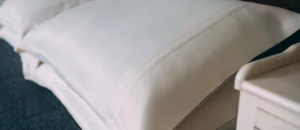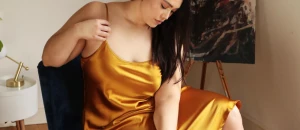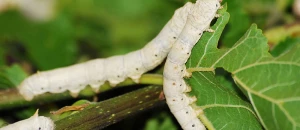For this Masterclass we are diving into varying perspectives that should help uncover and examine what ethical and sustainable silk means for you. We hear from traditional sericulturalists, handcraft textile producers, and organic and regenerative farms, and provide you with case studies of those who have done the research to solidify their actions.
Silk as a fibre and fabric accounts for only 0.1% of global fibre production, with 109,111 tonnes of the stuff being produced in 2020, in comparison to polyester at 109 million tonnes. Though despite it achieving only a tiny proportion of the market share, it is estimated that 300,000 households are involved in silk production - and, it is probably one of the most controversial fibres out there, gaining further ground in recent years as conversations around veganism and animal welfare increase.
In 2020, around 63% of all silk was produced in China, while India was the second-largest producer at 33%, both making up 96% of total production. Silk production volumes more than doubled from 1990 to 2019 but saw a decrease over the last five years. Despite this seeming lack of interest in this fibre, there are many commercial projects revitalising the cultivation of silk worms and their feed. With a lot of historic onus on silkworm lives, it has somewhat shifted to consider regenerative farming and biodiversity as more ethical and sustainable, in line with holistic changes in other fibre industries such as cotton.
The complexity of this fibre requires patience in speaking with producers, and recognition of the nuances. The lines of ethics and sustainability are blurred, and it is becoming moreso apparent that compromises may need to be made in order to advance this natural fibre. The industry undoubtedly needs to move away from synthetic materials (silk itself is a classic technical textile anyway), so it is your responsibility as a designer and maker to educate yourself on both sides of the story before you jump into your production.
In this Masterclass you will learn:
- What silk is, and how the fibre is produced in both traditional and non-violent ways
- How to navigate silk fibre and fabric terminology to suit your values and sourcing requirements
- The benefits of silk as a fabric, and what to look for in the latter stages of production i.e. finishing, dyeing and printing
- What sericulture looks like in different parts of India, China and Thailand
- Varying explanations of what the 'peace', 'ahimsa' or 'non-violent' silk production approach looks like in practice
- How regenerative and organic agricultural practices within silk can support sustainable livelihoods and healthy silkworms
- The importance of research and asking questions to enable solid decision-making
-
Understanding Silk Fabrics and Fibre Terminology
with Dr. Matias LangerRead More...Summary
In this 26 minute lesson, hear from Dr. Matias Langer, the founder of Germany-based silk fabric dealer Seidentraum. Seidentraum's fabrics are all sourced from organic non-violent silk producers in India and China, and in this interview we learn from Dr. Langer on what the importance of silk is, depiction of nuances in silk cultivation terminology, and how you can utilise silk as a beautiful fabric in your fashion brand, including how it can be dyed and printed according to organic standards.
-
Traditional Low Impact Indian Sericulture
with Madhulika ChoudharyRead More...Summary
In this bitesize 13 minute lesson, hear from Madhulika Choudhary, the founder of Mulberry 001. We learn from Madhulika about her silk production journey, including how Mulberry 001 operates their traditional low impact sericulture in India, and the differences between different types of silk. Madhulika and Mulberry 001 produce fabric most suitable for fashion, and so hear we also learn how this fabric can benefit designers choosing to work with silk.
-
Regenerative and Organic Silk Fibre Cultivation
with Hilmond HuiRead More...Summary
In this bumper 42 minute lesson, Vice President of Bombyx, Hilmond Hui, takes us through how they are combining traditional sericulture techniques with regenerative farming, technology and research to produce ethical, sustainable silk.
Bombyx is a 6-year project under the umbrella of PSGHL, a garment manufacturing hub in China. Their aim is to create a vertical supply chain that will ulimately decrease margins - silk is a massively expensive fabric after all - while increasing demand for better methods, such as regenerative farming. Here the onus is on the very start of the supply chain for silk fibre, with the inputs of mulberry leaves. Hilmond generously and energetically provides wisdom on what traditional sericulture looks like in China, what regenerative organic methods can bring to this industry and beyond, and the nuances of ethics when it comes to mulberry silk.
-
Unpicking Distinctions Between Ahimsa, Peace and Mulberry Silk
with Rajaiah KusumaRead More...Summary
In this 37 minute lesson, have the honour of listening to the pioneer of non-violent silk production, Mr Rajaiah Kusuma. With research and sheer grit over 10 years, Mr Kusuma was able to produce peace silk fibre and yarn, and in the year 2000 received the patent for Ahimsa™ silk, the trademarked non-violent silk production process. This is a lesson that will help you understand controversy and confusion in regards to claims of ethical silk, and provide you a history of where the need for such a fabric came from. Rajaiah Kusuma is a handloom technical expert, and weaves fabric using Ahimsa™ peace silk yarn for sale at Ahimsa Silks.
-
Increasing Sustainable Livelihoods With Traceable Organic Silk
with Chul Thai SilkRead More...Summary
In this endearing 14 minute lesson, learn from the family business of Chul Thai Silk in regards to how they transitioned to organic sericulture in their home base of Thailand, and support training of organic agricultural practices with marginalised farmers. Understand how organic silk production can be ethical for people, and how this approach to silkworm rearing will support healthy animals too.
-
Vegan Alternatives to Silk
with Charlie Bradley RossRead More...Summary
Silk is often touted as an all-natural, opulent fabric — but, as we know, these qualities are not synonymous with textiles that are good for the planet or benefit the people who make them. Manufacturing silk often hurts both the environment and the worms it uses, leaving many consumers looking for more eco-friendly, ethically-made, and vegan alternatives. This lesson identifies some accessible options and an exciting textile innovation.
Interviews
The Ethical Silk Company: Building A Brand Around Peace Silk Fabric and Fair Trade Production
Friday Oct 1st, 2021
Lora Gene: Investigation and Research (Of Silk) As A Tool For A Thriving Business
Friday Oct 1st, 2021
Technical Tutorials
Additional reading:
Ethical silk fabrics and what the complex terminology really means [The Sustainable Fashion Collective]
Silk: The production, pros and cons [The Sustainable Fashion Collective]
Different types of silk - and they aren't all from worms! [The Sustainable Fashion Collective]
How silk fabric comes to life - meeting our silk moths [The Sustainable Fashion Collective]
Preferred Fibre and Materials Report 2021 [Textile Exchange]
Follow on Masterclasses:
Education As A Tool For Change For Responsible Businesses

